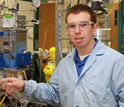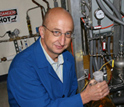|

Press Release 08-156
From Sugar to Gasoline

Using processes familiar to the petroleum industry, two separate research groups craft "green gasoline" from sugar and carbohydrates
September 17, 2008
View video interviews with John Regalbuto of the National Science Foundation, biochemist Clint Chapple from Purdue University, Randy Cortright, CTO of Virent Energy Systems, and chemical engineer George Huber from the University of Massachusetts at Amherst.
Following independent paths of investigation, two research teams are announcing this month that they have successfully converted sugar-potentially derived from agricultural waste and non-food plants-into gasoline, diesel, jet fuel and a range of other valuable chemicals. Chemical engineer Randy Cortright and his colleagues at Virent Energy Systems of Madison, Wisc., a National Science Foundation (NSF) Small Business Innovation Research awardee, and researchers led by NSF-supported chemical engineer James Dumesic of the University of Wisconsin at Madison are now announcing that sugars and carbohydrates can be processed like petroleum into the full suite of products that drive the fuel, pharmaceutical and chemical industries. "NSF and other federal funding agencies are advocating the new paradigm of next generation hydrocarbon biofuels," said John Regalbuto, director of the Catalysis and Biocatalysis Program at NSF and chair of an interagency working group on biomass conversion. "Even when solar and wind, in addition to clean coal and nuclear, become highly developed, and cars become electric or plug-in hybrid, we will still need high energy-density gasoline, diesel and jet fuel for planes, trains, trucks, and boats. The processes that these teams developed are superb examples of pathways that will enable the sustainable production of these fuels." The process Virent discovered in early 2006, and announced at the Growing the Bioeconomy conference sponsored by Iowa State University on Sept. 9, 2008, is the subject of patent applications published last week. That announcement was followed this month by the publication of a separate discovery of the same process in the Dumesic laboratory. Dumesic and his colleagues announce their findings in the Sept. 18, 2008 online ScienceExpress, to be followed in print in the Oct. 18, 2008, issue of Science. The key to the breakthrough is a process developed by both Dumesic and Cortright called aqueous phase reforming. In passing a watery slurry of plant-derived sugar and carbohydrates over a series of catalysts-materials that speed up reactions without sacrificing themselves in the process-carbon-rich organic molecules split apart into component elements that recombine to form many of the chemicals that are extracted from non-renewable petroleum. According to Dumesic, a key feature of the approach is that between the sugar or starch starter materials and the hydrocarbon end products, the chemicals go through an intermediate stage as an organic liquid composed of functional compounds. "The intermediate compounds retain 95 percent of the energy of the biomass but only about 40 percent of the mass, and can be upgraded into different types of transportation fuels, such as gasoline, jet and diesel fuels," said Dumesic. "Importantly, the formation of this functional intermediate oil does not require the need for an external source of hydrogen," he added, since hydrogen comes from the slurry itself. As part of a suite of second generation biofuel alternatives, green gasoline approaches like aqueous phase reforming are generating interest across the academic and industrial communities because they yield a product that is compatible with existing infrastructure, closer than many other alternatives in their net energy yield, and most importantly, can be crafted from plants grown in marginal soils, like switchgrass, or from agricultural waste. While several years of further development will be needed to refine the process and scale it for production, the promise of gasoline and other petrochemicals from renewable plants has led to broad industrial interest. Virent's process, called BioForming, is allowing the company to address one of the key goals of NSF's SBIR program, commercialization, and a broader NSF target, American competitiveness. A recent alliance with one of the world's largest energy companies aims to bring these alternative fuels to market, and investment from major automotive and agricultural companies from around the world are broadening the company's impact. "The early support of NSF helped lay the groundwork for our technical, and subsequent industrial, successes," said Cortright, chief technology officer at Virent. "Our scientists now have years of expertise with our BioForming process and are rapidly moving the technology to commercial scale. We are quickly working to put our renewable, green gasoline and other hydrocarbon biofuels in fuel tanks all over the world." Added Rose Wesson, the NSF program officer who oversaw Virent's grant, "The technology developed by Virent is extremely promising, and has been refined over the last six years. The aqueous phase reforming process used by both research is an innovative approach that may yield an important, positive impact on the energy demands of the U.S. and worldwide." On Sept. 23, 2008, at 2:00 p.m., three leading experts from academia and industry, including Randy Cortright and George Huber, both former students of Jim Dumesic, will host a panel discussion at NSF to highlight how far researchers have come, and how far they still need to go, to bring plant-derived gasoline to market. For additional information, see the media advisory at: http://nsf.gov/news/news_summ.jsp?cntn_id=112243. Related press release:
Money Doesn't Grow on Trees, But Gasoline Might Related fact sheet:
What Is Green Gasoline?
-NSF-

Media Contacts
Joshua A. Chamot, NSF (703) 292-7730 jchamot@nsf.gov
Madeline Fisher, University of Wisconsin-Madison (608) 890-0465 mmfisher@wisc.edu
Mary Blanchard, Virent Energy Systems, Inc. (608) 237 8615 mary_blanchard@virent.com
Program Contacts
John Regalbuto, NSF (703) 292-7047 jregalbu@nsf.gov
Rosemarie D. Wesson, NSF (703) 292-7070 rwesson@nsf.gov
Principal Investigators
James Dumesic, University of Wisconsin-Madison (608) 262-1095 dumesic@cae.wisc.edu
Randy Cortright, Virent Energy Systems, Inc. (608) 663-0228 randy_cortright@virent.com

The National Science Foundation (NSF) is an independent federal agency that
supports fundamental research and education across all fields of science and
engineering, with an annual budget of $6.06 billion. NSF funds reach all 50
states through grants to over 1,900 universities and institutions. Each year,
NSF receives about 45,000 competitive requests for funding, and makes over
11,500 new funding awards. NSF also awards over $400 million in
professional and service contracts yearly.
 Get News Updates by Email Get News Updates by Email
Useful NSF Web Sites:
NSF Home Page: http://www.nsf.gov
NSF News: http://www.nsf.gov/news/
For the News Media: http://www.nsf.gov/news/newsroom.jsp
Science and Engineering Statistics: http://www.nsf.gov/statistics/
Awards Searches: http://www.nsf.gov/awardsearch/
| 









